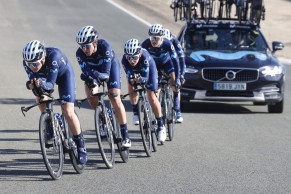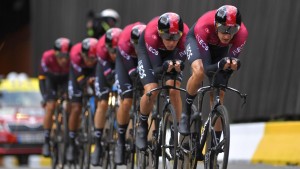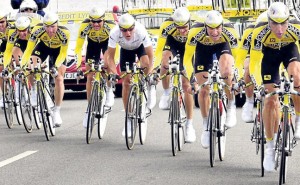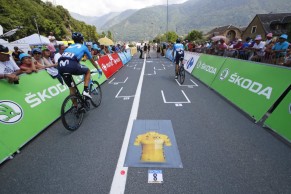How is the new time trial that Paris Nice is premiering today?
ASO, organizer of the Tour de France and Paris-Nice among others, continues to test innovative forms of competition. If a few years ago it was the idea of starting a stage using a Formula 1-style starting grid, now they surprise with the individual time taking in the team time trial that will take place today in the Race to the Sun.

Surprising innovation in the team time trial at Paris-Nice
It seems to be clear that, based on the routes of the 2023 Tour de France and the next edition of La Vuelta a España that was presented yesterday, ASO does not like time trials, at least in the traditional format in which they have been contested throughout the history of the sport.
In addition to the reduction in the number of kilometers of individual time trials to which the two grand tours under its umbrella have been subjected, the team time trial of the 3rd stage of the next Paris-Nice will be contested in a new format.
RECOMENDADO

When do helmets have to be changed? Do they have an expiration date?

The best apps for cycling and mountain biking

Black Friday 2025 cycling bargains: save on Garmin, POC, Maxxis and more

Black Friday Garmin 2025: the ultimate guide to choosing your GPS at the best price

Which profile wheels to choose according to the area where you live: mountain, flat or coast

How to wash your cycling clothes? 10 keys to make them always look new

The change is that, although it is a time trial by teams, the times will be taken individually, with all the implications in terms of strategy that can cause in the dispute of this stage.
At present, in team time trials, riders are given a time set by the third rider in the squad to cross the finish line, except for those who break away from the group, in which case they are assigned their individual time.
This forces the teams to keep the structure together for most of the course in order to finish with at least three riders. The time trial specialists must measure their strength in order not to break up the group and protect the climbers, a figure that often also coincides with that of the team leaders.

With the new format proposed by ASO for Paris-Nice, the options for approaching the time trial would be very diverse, with a strong leader against the clock being able to give the maximum as if it were an individual time trial. A rocket-like tactic could also be considered, in which the team would burn stages, as we see in the summit finishes, to leave its leader alone in the last kilometers, being able to make a maximum effort in that stretch to create differences, which would benefit the less time trialists who can crouch behind the wheel of their teammates without the need to share the effort.
In any case, nothing changes if a rider gets off the pace, since when this situation occurred the rider received the individual time he/she had achieved.
The team time trial of this third stage brings back this discipline that has not been used in Paris-Nice since 1993, a stage in which the ONCE team won in the town of Roanne.

The French organization is not very given to this type of experiments, with races traditionally based on repeating the formula that has been working for years. However, they have surprised us on occasion with curious proposals such as the one experimented in the 17th stage of the 2018 Tour de France.
This stage, one of the decisive days of the Pyrenees, started in the town of Bagneres de Luchon to head, in a route of just 65 km, towards the Col de Portet, ascending, practically from the starting line, the Peyresourde, the first pass of the day.

The novelty that day was that the riders took the start placed on a grid according to their position in the general classification although, as there was no time separation between their start and that of the rest of the peloton, that was just a curious photo.
We will have to see how this new experiment with the team time trial in Paris-Nice results out and if it helps ASO to take more into account a modality that has been mistreated in recent times with fewer and fewer races and lower mileage, which gives all the attention to the mountainous terrain, as well as giving greater importance to the bonuses at the finish line.